Markets have been on a roller coaster ride. Here are our latest forex trading ideas.
Markets overview
Another round of key data releases and macro events will keep forex traders on edge this week.
The dollar index (DXY) reversed a five-week losing streak last week after data from the US highlighted a certain resilience of economic activity with renewed upside risks to the inflation picture. The US private sector activity barometer, as assessed by S&P Global, increased faster than predicted to an 11-month high in April, suggesting expansion in both the services and manufacturing sectors and relieving some early recessionary fears. This raised the prospect of a resurgence of hawkish talks among Fed officials.
Last week's weakest major currencies were the high-beta Canadian (CAD) and New Zealand (NZD) dollars, both down 1.2% vs. USD, indicating some growing risk aversion among traders.
On the data front, the focus for the United States will be on durable goods orders and new home sales on Wednesday, the advance estimate for Q1 GDP growth rate on Thursday, personal income and spending, and the PCE price index on Friday. Stronger-than-expected statistics, especially on Q1 GDP (2% estimated) and March Core PCE (0.3% month on month est.), are likely to support bets on the Fed funds rate being higher for longer and would be bullish for the dollar. Overall, inflation has fallen mostly due to energy, although core inflation has remained stubbornly sticky. U.S. Treasury yields have risen sharply from their March lows as markets have pushed Fed rate cuts farther down the road this year, with the first rate cut fully priced by November.
This week will be a busy one for data in the Eurozone, with April's economic confidence, consumer inflation expectations, industrial/service sentiment, and the Eurogroup meeting on Thursday, and flash estimates of Q1 GDP growth (1.4% expected) and preliminary April inflation rates for Germany/France/Spain on Friday. In terms of ECB speeches, we have Panetta (Monday), De Guindos (Wednesday), and Lagarde (Friday). Markets are now pricing an ECB rate peak of 3.75%, but stronger-than-expected April CPI readings might add an extra kick there, especially for the July/September meetings, which are currently pricing greater odds of no hikes.
Elsewhere, the Bank of Japan meets on Thursday, but the market does not expect major changes in the first meeting of the new governor, Kazuo Ueda, who is expected to retain the existing yield curve control range and postpone any adjustment to June.
However, the BoJ can remark on Japan's core consumer price index, coming in at 3.1% y/y last month and surpassing the target for eleven months in a row now.
Other G7 key figures include Australia's Q1 CPI print (6.9% year-on-year expected), while the GBP and CHF will have a pretty quiet week in terms of data.
Open Trades From Last Week:
• Short EUR/USD: Target Price 1.0713; Stop Loss 1.1095.
• Long USD/CHF: Target Price 0.92, Stop Loss 0.885.
• Short GBP/USD: Target Price 1.2178; Stop Loss 1.2483
EUR/USD Trading Strategy: Bears To Reclaim Some Ground Ahead of The Fed
Short EUR/USD: Target 1.07; Stop Loss 1.11; Risk/reward of 3.3
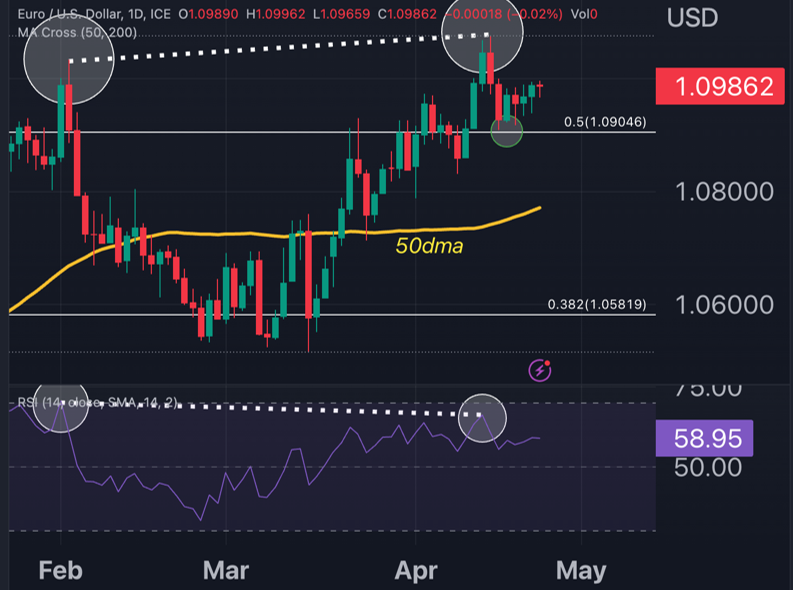
We went short EUR/USD at the start of last week as the pair generated a bearish RSI divergence on the daily chart.
The euro first traded lower but then rebounded off the 50% Fibonacci level of the 2021-2022 high-low range.
At the time of writing, the pair is testing psychological resistance of 1.10, which corresponds to last week's highs.
We continue to think that the pair could test the 50-day moving average at 1,077, which if broken could lead to a bearish extension up to 1.07, currently about 2.5% away from current levels.
Lots will depend on US/EU data due out this week, but overall a positive dollar sentiment could take over ahead of the Fed meeting on May 3.
This is because, as seen in the figure below, the short-term rate differential, defined as the difference in yield between German 2-year rates and US 2-year yields, has recently returned to being the primary driver of EUR/USD.
The current 2-year Treasury yield is 4.15%, which is somewhat lower than the December 2023 fed funds rate price of 4.6%. As a result, there is an opportunity for a rise in US short-term bond rates, which will serve as a headwind for the EUR/USD.
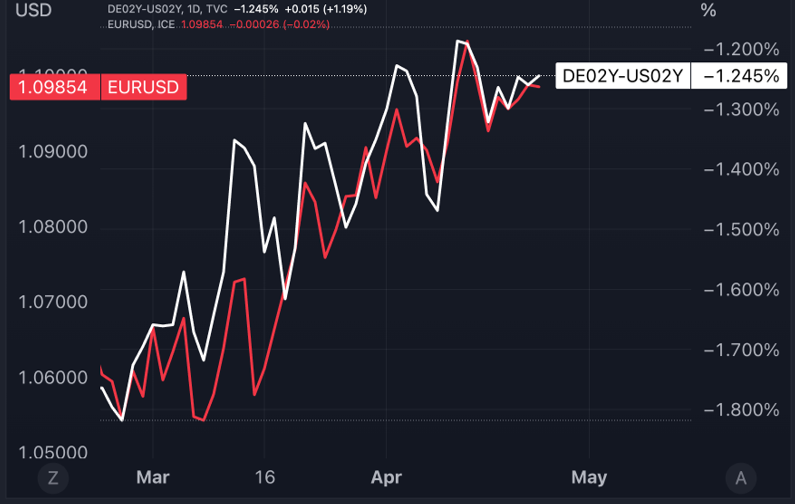
USD/JPY Trading Strategy: Bulls Are Back in The Ring
Long USD/JPY: Target 138; Stop Loss 132.5; Risk/reward ratio of 2.12
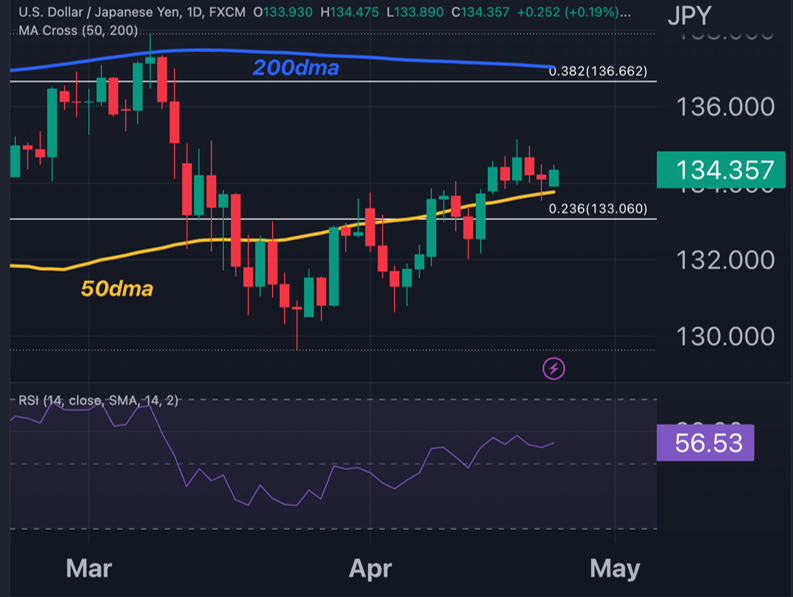
The dollar-yen pair is experiencing an interesting rebound from late March levels, supported by the resilience of US macro data that led to a higher repricing of Fed interest rates.
This week the BoJ meets but there is no particular change in the policy, although risks of hawkish remarks exist.
However, the pair is trading at a discount to the current level of the 10-year US-Japan rate differential. The current spread of 3% is consistent with USD/JPY trading in the 136-137 area, rather than 134, as the chart below shows.
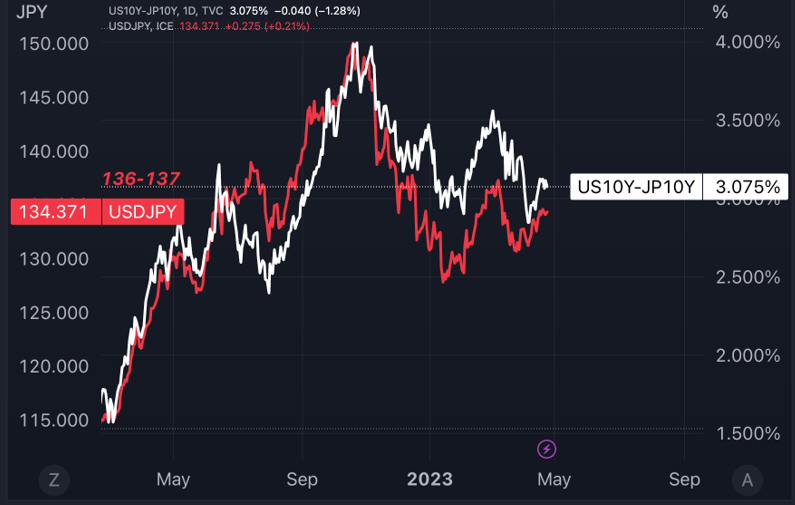
Technically, we believe bulls could still recover after they defended 50-day moving average levels very well last week, keeping the daily RSI above 50.
An interesting target is given by a multi-resistance zone marked by 136.7 (38.2% retracement of the October '22-January '23 high-to-low range); 137 (psychological and 200-day moving average) and then 137.94 (2023 highs). The level of the stop could be placed just below the 23.6% Fibo level of the above-mentioned range.
AUD/USD Trading Strategy: Death Cross Formed
Short AUD/USD: Target 0.638; Stop loss 0.678; Risk/reward ratio of 2.65
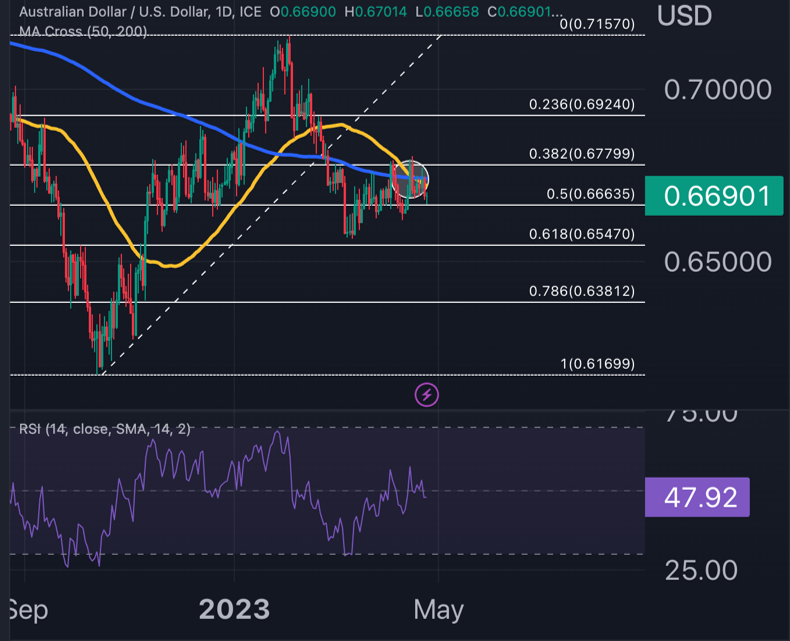
Technically, AUD/USD has given a bearish signal following the formation of a death-cross pattern last week, as indicated by the crossing of the 50-day moving average below the 200-day moving average.
The pair is currently testing the 50% retracement of the October ’22-January ’23 bullish range.
We like 0.638 as the potential target level, corresponding to the 78.6% retracement of that range, although we recognize that some strong bullish support may resurface at 0.655 (61.8% retracement and strong resistance in Q4 2022).
The biggest data point for the AUD will be the Q1 inflation print for Australia, which is coming on Tuesday, a week prior to the Reserve Bank of Australia meeting.
Annual inflation is expected to fall from 7.8% in Q4 2022 to 6.9% in Q1 2023, with the March monthly CPI gauge expected to be 6.5%.
If the reading is in line with or below expectations, this could generate a substantial amount of bearish sentiment against the AUD, as markets will likely cement expectations of an RBA pause in May.
Whether you're a novice trader or an experienced one, "Learn Forex Trading with FlowBank" offers you a structured and effective path to becoming a confident and profitable forex trader.




